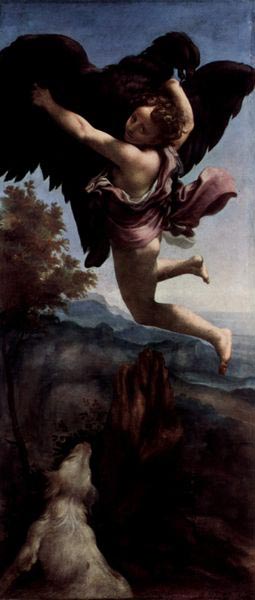Let us go back 500 years in time and examine art that has survived the centuries and continues to elicit a powerful emotional response today – the works of Antonio da Correggio, the Italian painter who is considered the premier artist of the Parma school.
Most commonly known as Correggio, Antonio da Correggio was born in Correggio, Italy, three years before Columbus landed in the Americas in 1492. His life was relatively short. He died in 1534 at just 45 years of age, but the art he left behind was of enormous influence on later generations.
Powerful Eclectic Style
The work of Correggio is often described as erotic, vigorous, sensual, dynamic and dramatic. He excelled at bringing mythological subjects to life, such as his depiction of Ganyemede being abducted by an eagle, completed in 1531. His art may have been one of the primary drivers behind the later development of the Baroque style, but even more amazing, his work foreshadowed the emergence of the Rococo style which dominated the 18th Century 300 years after his death.
A Melancholy Man
Like many artists from a more distant past, the details of his early life are unclear. He was the son of a merchant and his family was large and poor. This may explain why he was generally known to be a depressive loner. Some historians have described Correggio as “introverted” and “mysterious.”
It is unknown if he trained under another established artist – though some believe he may have worked with Francesco Bianchi Ferrara of Modena. If he did, it was only for a year or two.
Highly Innovative
 Although it is uncertain if he received formal art instruction or not, he was definitely influenced by other artists, evidence of this is apparent in his work. He also knew the great artists Andrea Mantegna, Lorenzo Costa, and Francesco Francia.
Although it is uncertain if he received formal art instruction or not, he was definitely influenced by other artists, evidence of this is apparent in his work. He also knew the great artists Andrea Mantegna, Lorenzo Costa, and Francesco Francia.
It is almost certain he had a considerable reputation and gained respect in the artistic community, as evidenced by his commission to create three works of art for church of Sant’Andrea in Mantu. These were “tondos’ which are circular pieces of art. His first major commission came in 1519 to paint the ceiling of the convent of St. Paul in Parma, Italy.
Correggio married Girolama Francesca di Braghetis in 1516. They had a son, Pomponio Allegri, who also became a painter but never had the same skill and fame of his father. After completing the St. Paul convent commission, Correggio remained in Parma for most of the rest of his life, living and working at his craft.
Defies Categorization
Correggio is among the most difficult of artists to pin down in terms of style. His works were wide ranging and eclectic. Like many great artists, Correggio did not adopt one style, or subscribe to a particular school of art theory, he went his own way and blazed a stylistic path for those who followed.
 Correggio often liked to experiment with illusions. He was not adverse to replacing natural spaces with a kind of self-invented imaginary reality. Because of this, he is sometimes considered the “grandfather” of Mannerism, and also presaged the Baroque school.
Correggio often liked to experiment with illusions. He was not adverse to replacing natural spaces with a kind of self-invented imaginary reality. Because of this, he is sometimes considered the “grandfather” of Mannerism, and also presaged the Baroque school.
His most important contribution to High Renaissance art is The Mystic Marriage of St. Catherine, completed in 1527. It is believed that this work was influenced by Leonardo da Vinci.
Greatest Works
One of his most highly regarded works is Jupiter and Io, an erotically charged depiction of the goddess Io being seduced by Jupiter, the Roman equivalent of Zeus. In this depiction, Io is nude with her back to us. Jupiter is rendered as a barely distinguishable cloudy figure, whom nevertheless clearly appears to be grasping her around the waste and kissing her face. It was completed in 1531.
Like many artists of his day and region, many of Correggio’s paintings were of Biblical scenes, however he really excelled with mythological depictions of Greek and Roman antiquity.
In 2008 the Galleria Borghese in Rome exhibited works of Correggio. Art historians associated with the Borghese called Correggio one of the three artists who made up the “Renaissance Triad.” The other two are Michelangelo and Raphael. Deserving to be in this luminous company, Correggio can easily be placed among the greatest artists in all of history.
